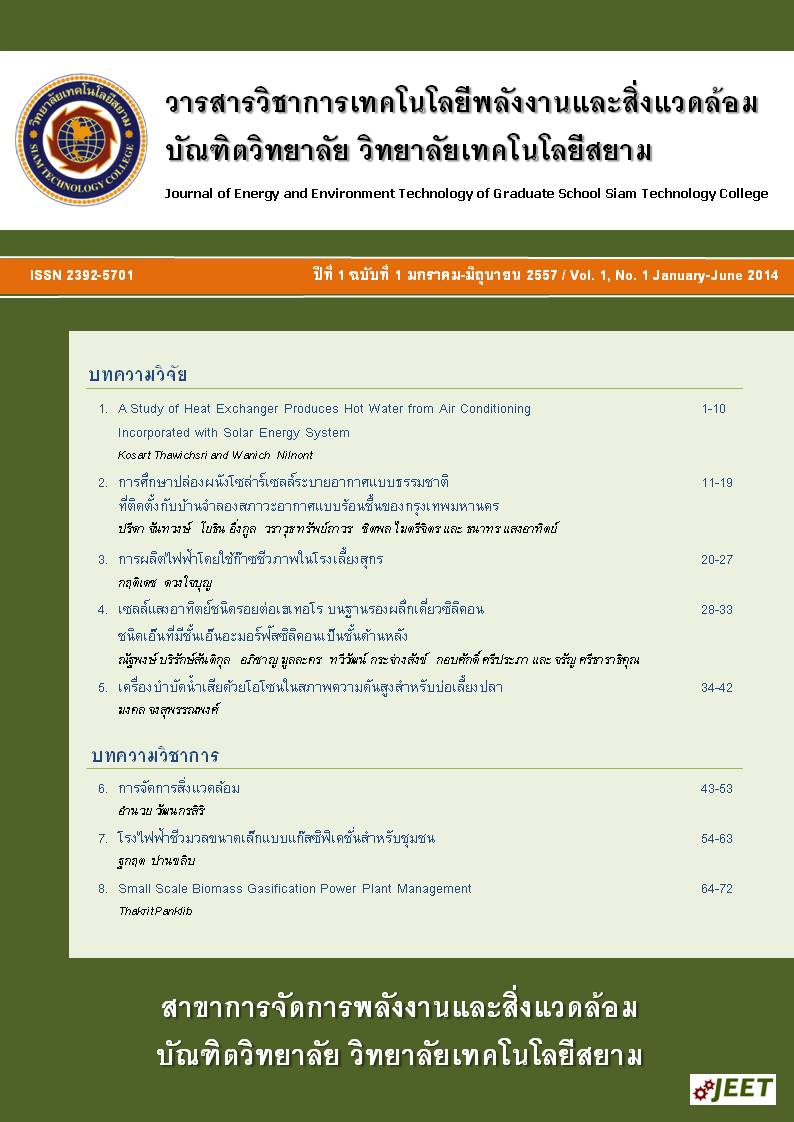Environmental Management
Main Article Content
Abstract
Environmental problems are an important issue that worldwide countries explicitly express their awareness. Environmental management is then very important to lessen these environmental problems. This review article will address the importance of environmental management. First, environmental compartments will be described because the environment is always dynamic. The environmental management is needed to plan and manage as represented by the case study of Bangpakong River and Plan-Do-Check-Act (PDCA) technique is effectively applied to manage the environment. Besides, ISO (International Organization for Standardization) 14000 and clean technology are valuable to apply in organizations. Lastly, the creation of environmental management network with stakeholders’ cooperation will raise incentive and awareness to lessen environmental problems in organizations and communities.
Article Details
เนื้อหาและข่อมูลในบทความที่ลงตีพิมพ์ในวารสารวิชาการ เทคโนโลยี พลังงาน และสิ่งแวดล้อม บัณฑิตวิทยาลัย วิทยาลัยเทคโนโลยีสยาม ถือเป็นข้อคิดเห็นและความรับผิดชอบของผู้เขียนบทความโดยตรง ซึ่งกองบรรณาธิการวารสารไม่จำเป็นต้องเห็นด้วย หรือว่าร่วมรับผิดชอบใด ๆ
บทความ ข้อมูล เนื้อหา รูปภาพ ฯลฯ ที่ได้รับการตีพิมพ์ในวารสารวิชาการ เทคโนโลยี พลังงาน และสิ่งแวดล้อม บัณฑิตวิทยาลัย วิทยาลัยเทคโนโลยีสยาม ถือเป็นลิขสิทธิ์ของวารสารวิชาการ เทคโนโลยี พลังงาน และสิ่งแวดล้อม บัณฑิตวิทยาลัย วิทยาลัยเทคโนโลยีสยาม หากบุคคล หรือหน่วยงานใดต้องการนำทั้งหมด หรือส่วนหนึ่งส่วนใดไปเผยแพร่ต่อ หรือเพื่อกระทำการใด ๆ จะต้องได้รับอนุญาต เป็นลายลักษณ์อักษรจากวารสารวิชาการ เทคโนโลยี พลังงาน และสิ่งแวดล้อม บัณฑิตวิทยาลัย วิทยาลัยเทคโนโลยีสยาม เท่านั้น
References
[2] CH Walker, SP Hopkin, RM Sibly and DB Peakall. Principles of Ecotoxicology. 3rd ed. Taylor & Francis, New York, 2006.
[3] ชาลี นาวานุเคราะห์. วิทยาศาสตร์ของโลกทั้งระบบ (Earth System Science). คณะสิ่งแวดล้อมและทรัพยากรศาสตร์ มหาวิทยาลัยมหิดล, นครปฐม, 2550.
[4] JS Gulliver. Introduction to Chemical Transport in the Environment. Cambridge University Press, New York, 2007.
[5] เกษม จันทร์แก้ว. วิทยาศาสตร์สิ่งแวดล้อม. มหาวิทยาลัยเกษตรศาสตร์, กรุงเทพมหานคร, 2544.
[6] กรมการปกครองส่วนท้องถิ่น. มาตรฐานการจัดการสิ่งแวดล้อม. กรมการปกครองส่วนท้องถิ่น กระทรวงมหาดไทย, กรุงเทพมหานคร, 2550.
[7] JE Cloern, Available at: www.eoearth.org/article/Eutrophication, accessed April 2014.
[8] MW Holdgate. A Perspective of Environmental Pollution. Cambridge University Press, Cambridge, 1979.
[9] แหล่งแลกเปลี่ยนเรียนรู้ชาวนคร, Available at: www.nstlearning.com/~km/?cat=22, accessed April 2014.
[10] P Sawangwong. Handouts for the Course of Advanced Aquatic Pollution: Chapter 6 – Pollution and Self-purification of Streams and River. Burapha University, Thailand, 2008.
[11] WE Deming, Available at: http://www.iiquality.com/seminars/deming_cycle.php, accessed April 2014.
[12] เดช เฉิดสุวรรณรักษ์, Available at: www.tccnature.wordpress.com/2008/01/07, accessed April 2014.
[13] กรมโรงงานอุตสาหกรรม, Available at: www.diw.go.th/iso/iso14000.html, accessed April 2014.
[14] A Wattanakornsiri, J Nanuam, S Tongnunui and K Pachana. Clean Technology: An Effective Tool for Pollution Prevention. Koch Cha Sarn Journal of Science. 2009, 32, 77-88.
[15] P Sittisunthorn, P Reanwattana and S Pengpreecha. Research Report: Feasibility Study on Clean Technology for Chemical Industry in Thailand. Thailand Environment Institute, Bangkok, Thailand, 1998.
[16] A Remmen. Greening of Industry – Technological and Industrial Innovations. Aalborg University, Aalborg, Denmark, 1999.


